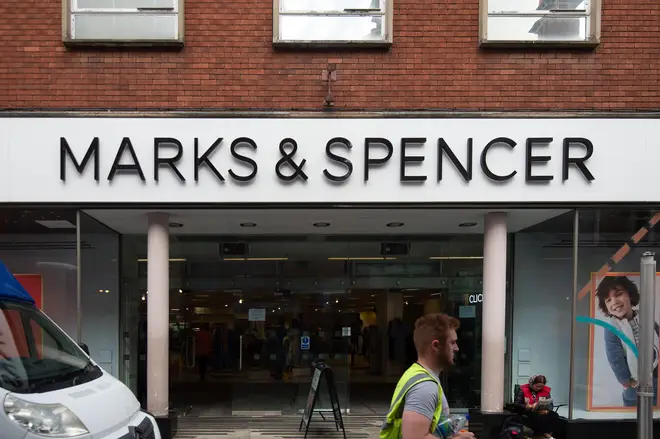
Vanessa Feltz 3pm - 6pm
4 September 2023, 11:52

Having spent an embarrassing four years in the wilderness, out of the FTSE 100, investors and consumers alike were delighted to see Mark & Spencer return to the ‘topflight’ this month.
This elevation has been orchestrated by its innovative and globally respected chairman, Archie Norman. He would be the first to acknowledge the efforts and achievements of the joint CEOS Stuart Machin, a ‘lifer’ at the UK’S best known retail brand, and Katie Bickerstaffe, nor forgetting contribution made by 72,000 employees.
M&S is forecasted to make a profit PBT of circa £516 million in 2023, having posted a pre-tax profit of £482 million on a turnover of £11.9 billion last year. The first nineteen weeks has seen like for like food sales up 11% and clothes and merchandising up 6%. This has been a splendid effort, resulting in the share price rallying to 227p by 79% year to date. In October of last year their shares dipped to 98p. The recovery has been meteoric.
However, this improvement only goes to illustrate how far M&S fell from grace, in terms of profitability. It is hard to fathom that M&S did in fact make a £1 billion profit on two occasions – in 1997, when Sir Richard Greenbury was CEO and in 2007 under Stuart Rose’s stewardship. It should not be forgotten that M&S shares stood at 700p in May 2007. The massive 2007 profit manifested itself, after the combined efforts of Lord Paul Myners as chairman, who is sadly no longer with us, and Stuart Rose had been successful in fighting off Sir Philip Green’s bid to buy M&S for £4 a share in 2004. Ever since 2009, when Marc Bolland left Wm Morrison to succeed Lord Rose CEO, M&S has enjoyed a torrid time. The retail environment was changing.
This much-loved brand seemed to lose its way in the fashion arena, despite using the expansive services of the likes of designers such as George Smith and adding labels such as Autograph to its fashion portfolio. The young (16 to 40 years old) appeared to be unattracted by their fashions on offer, finding them dowdy and there is little doubt that between 2008 and 2020 M&S lost significant market share to other retailers. Once that share of the cake has been lost it is hard to regain it.
Many retail luminaries thought that Kate Bostock, who oversaw fashion development between 2004 and 2008, may have outstayed her welcome, as the fashion-conscious public deserted the M&S brand in their droves. Consumers became more price conscious as well as more imaginative in their choice of clothing. NEXT, under the shrewd guidance of Lord Simon Wolfson was becoming increasingly popular. Arcadia and BHS were still popular, before economic events overtook the ‘Sir Philip Green empire’. Hennes & Mauritz and Inditex (Zara) were making a huge splash on the High Street. The John Lewis Partnership has remained in the vanguard, though many feel it has fashion issues to attend to.
The young soon cottoned on to the value and attractiveness of Primark (AB Foods), Boohoo, ASOS, Uniqlo and many others. M&S was very late on the scene in terms of recognising the value of an online service. This shortcoming has been dealt with. The management has been aggressive in cutting costs, closing branches that are unprofitable, whilst dealing with sales and marketing attractive fashions both in house and with other varieties of brands, such as Ted Baker, Superdry and Crew Clothing.
Steve Rowe left as CEO in 2022 after 6 years and 37 years in M&S’S employ. He started the recovery process, but the current management of Messrs Norman, Machin and Bickerstaffe have selected another gear. They will be disappointed that Michael Gove has refused M&S permission to redevelop their flagship store on Oxford Street. Let’s hope there is an appeal. The UK’S retail hub urgently needs a face-lift. It was interesting to note that Selfridges supported the idea. Long may the renaissance continue
Retail is a key component for growth across the global spectrum, accounting for about 70% of GDP in the US and 60% in the UK. Economic conditions have not been great this year, but retail has remained relatively robust. Set out below are some simple tables illustrating share performances of leading brands in UK, USA and Europe so far this year. In the US Abercrombie & Fitch has put in a storming performance this year. It just goes to show that if a retailer puts the right stock on the shelves online at the right price, they will sell. I have taken the trouble of flagging up Walmart.
As an operation, it is all things to many people who live not only in rural areas, but also in densely populated urban areas. Walmart’s shares are up 12.50% year to date, reaching an all time high of $162.61 ahead of Labor Day. Consolidated revenue for the last quarter came in at $161.6 billion, up 5.7%! To put Walmart’s revenue size into perspective, it is bigger than Nigeria, Austria, and Argentina. There is still Thanksgiving and Cyber Friday to come. It will be fascinating to see if retail enthusiasm is maintained come November.
UK RETAIL Year-To-Date - NEXT +17.93%, M&S +79.87%, HALFORDS -14.51%, BOOHOO +2.60%, AB FOODS +22.10%, THG +112.10%, CURRYS -11.96%, WH SMITH -2.24%, AO WORLD +65.74%, FRASERS +12.15%, BURBERRY +5.66%, JD SPORTS +11.57%, ASOS -14.74%
US RETAIL Year-T0-Date – ABERCROMBIE & FITCH +130.93%, NORDSTROM +0.07%, NIKE -13.80%, FOOT LOCKER -46.80%, URBAN OUTFITTERS +36.77%, MACY’S -39.56%, AMERICAN EAGLE OUTFITTERS +20.14%, TJX +17.18%.
EUROPEAN RETAIL Year-To-Date – LVMH +11.77%, INDITEX (Ara) +36.72% HENNES & MAURITZ +44.64%